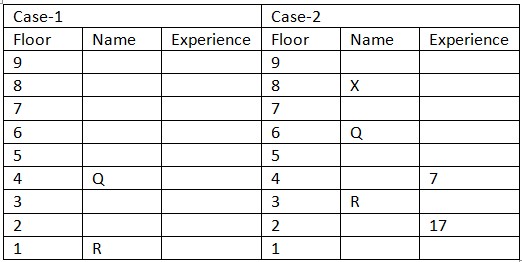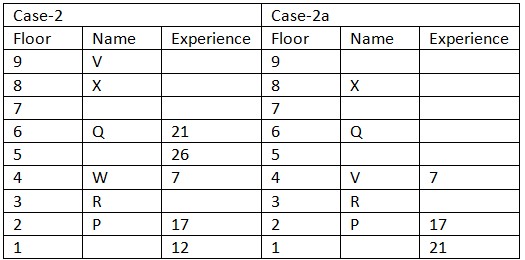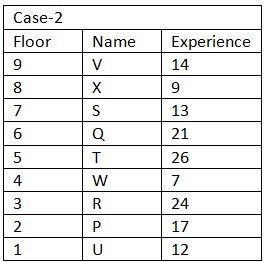Question
If all the persons from the top of the building live in
ascending order of their experience then, the floor of how many persons remains unchanged? Study the following information carefully and answer the below questions. Nine persons namely – P, Q, R, S, T, U, V, W, and X live in a nine floored building marked 1 to 9 from bottom to top. Each person has different working experience viz.- 7, 9, 12, 13, 14, 17, 21, 24, and 26. All the information is not necessary in the same order. Note: The experience of the persons living on the adjacent floor is neither a common factor nor a common multiple. Q lives on an even number floor. R, who lives on any floor below floor number 4, lives three floors away from Q and doesn’t have experience of 12 years. W lives on any floor above the one whose experience is 12 years but not adjacent to Q’s floor. Neither Q nor R lives on the adjacent floor of X, who lives four floors away from the one whose experience is 7 years. V lives three floors above the one whose experience is 21 years. The number of persons living between Q and X is the same as the number of persons living below P, whose experience is 17 years. The number of persons living between V and the one whose experience is 26 years is one more than the number of persons living between the one whose experience is 12 years and W. Experience of X is neither 26 nor 14 years. The one whose experience is 14 years lives two floors away from S. The number of persons living between S and Q is the same as between S and the one whose experience is 9 years. W doesn’t live on the topmost floor. U has less experience than T.Solution
Q lives on an even number floor. R, who lives on any floor below floor number 4, lives three floors away from Q and doesn’t have experience of 12 years. That means, in case (2) Q lives on floor number 6, in case (1) Q lives on floor number 4. Neither Q nor R lives on the adjacent floor of X, who lives four floors away from the one whose experience is 7 years. The number of persons living between Q and X is the same as the number of persons living below P, whose experience is 17 years. That means, in case (2) X lives on floor number 8, case (1) is not valid. Based on the above given information we have:  Case (1) is not valid as the number of persons living between Q and X is the same as the number of persons living below P, whose experience is 17 years. Again, we have: V lives three floors above the one whose experience is 21 years. That means, in case (2) V lives on floor number 9, in case (2a) V lives on floor number 4. The number of persons living between V and the one whose experience is 26 years is one more than the number of persons living between the one whose experience is 12 years and W. The experience of X is neither 26 nor 14 years. W lives on any floor above the one whose experience is 12 years but not adjacent to Q’s floor. W doesn’t live on the topmost floor. That means, in case (2) the one whose experience is 12 years lives on floor number 1, case (2a) is not valid. Based on the above given information we have:
Case (1) is not valid as the number of persons living between Q and X is the same as the number of persons living below P, whose experience is 17 years. Again, we have: V lives three floors above the one whose experience is 21 years. That means, in case (2) V lives on floor number 9, in case (2a) V lives on floor number 4. The number of persons living between V and the one whose experience is 26 years is one more than the number of persons living between the one whose experience is 12 years and W. The experience of X is neither 26 nor 14 years. W lives on any floor above the one whose experience is 12 years but not adjacent to Q’s floor. W doesn’t live on the topmost floor. That means, in case (2) the one whose experience is 12 years lives on floor number 1, case (2a) is not valid. Based on the above given information we have:  Case (2a) is not valid as W lives on any floor above the one whose experience is 12 years but not adjacent to Q’s floor and W doesn’t live on the topmost floor. Again, we have: The one whose experience is 14 years lives two floors away from S. U has less experience than T. The number of persons living between S and Q is the same as between S and the one whose experience is 9 years. Since, persons whose experiences are in common multiple are not living on the adjacent floor. This, the experience of S is 13 years. Based on the above given information we have
Case (2a) is not valid as W lives on any floor above the one whose experience is 12 years but not adjacent to Q’s floor and W doesn’t live on the topmost floor. Again, we have: The one whose experience is 14 years lives two floors away from S. U has less experience than T. The number of persons living between S and Q is the same as between S and the one whose experience is 9 years. Since, persons whose experiences are in common multiple are not living on the adjacent floor. This, the experience of S is 13 years. Based on the above given information we have 
Which legal maxim means let the buyer beware?
What is the prescribed time limit for the Rent Control Court to dispose of a complaint filed under the Maharashtra Rent Control Act?
Under administrative law, "Dichotomy" refers to:
The phase of modernism and post modernism under Jurisprudence emerged during which of the following time periods?
Which of the following is NOT an essential condition of performance of a contract under the Indian Contract Act 1872?
Who conducts community mediation under The Mediation Act, 2023?
A person who finds goods belonging to another, and takes them into his custody, is subject to the same responsibility as a________________
Which of the following is not a qualification for election of the President as laid down under the Indian Constitution?
Under the Income Tax Act, 1961, which of the following incomes is fully exempt from tax in the hands of the individual taxpayer?
Which section of the Prevention of Corruption Act, 1988 empowers the special judges to try the offence in a summary way?
Relevant for Exams:


